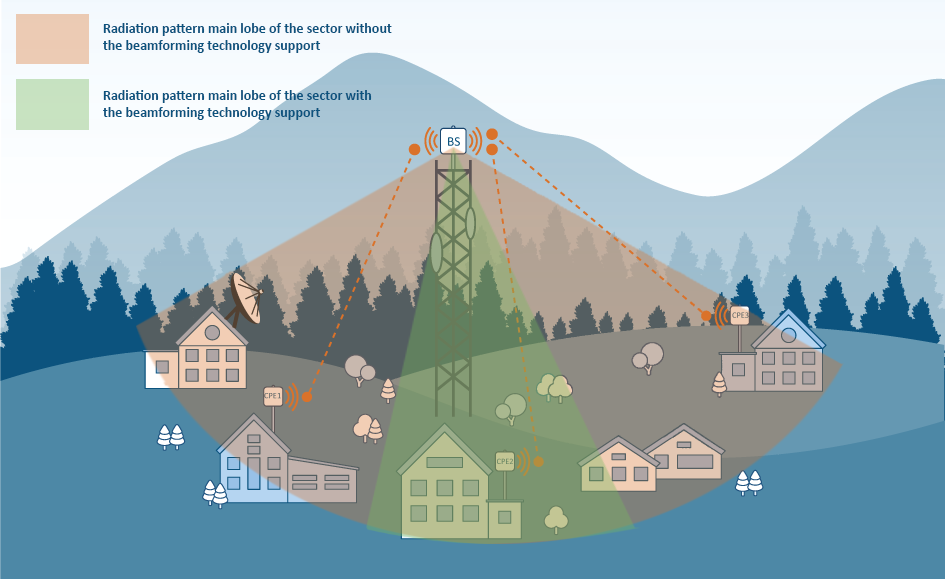| Include Page | ||||
|---|---|---|---|---|
|
| Table of Contents |
|---|
| Hide_comments |
|---|
...
This approach has several disadvantages:
- Inefficient use of radiated the radiated power (the sector performs data transmission to all subscriber devices that are within the coverage area, regardless of the recipient device), i.e. the link power with a specific subscriber unit can be higher.
- Low security level (by gaining access to one of the subscriber devices, the attacker can intercept the whole outgoing traffic of the sector for all subscribers).
- The appearance of local interference on the sector affects the operation of all the subscriber devices that are connected to this sector.
...
The beamforming technology is the ability to control the antenna's radiation pattern, i.e. depending on the situation, an the antenna narrows the radiation pattern main lobe and orients it in the required direction. Thus each subscriber will benefit of its own directional radiation pattern and an individual configuration will be used for data transmission to this subscriber. Note that the selected radiation pattern will be used for bidirectional exchange, i.e. both for reception and transmission.
...
| Center |
|---|
Figure 1 - Radiation pattern of the sector with the beamforming technology support and without it |
- improved Improved directional properties of the antenna. Allows to increase security by reducing the risks of all sector's subscribers data interception. In case of beamforming technology support, the data transmission is performed only in the subscriber direction, therefore if an an attacker performs similar actions, he will be able to access only the data of one subscriber.
- The ability to select the radiation direction automatically, reduces the requirements for the alignment and allows to determine the azimuth of the subscriber location, which can be useful in some scenarios (ex. with mobile objects).
- Using the BS sector with beamforming antenna reduces the local interference influence. Video 4 shows the interference effect in case of beamforming antenna usage. The noise falls into the side lobe of the radiation pattern, when the second and third subscribers are servicing, and does not have a significant effect on the useful signal. Since the data transmission direction to the first subscriber and the interference source coincide, the use of beamforming technology does not allow to reduce the local interference influence for this device. Although the beamforming technology support does not allow to completely neutralize the influence of interferences, its use can significantly improve the performance and reliability of the communication in some scenarios.
...
In the InfiNet company's product portfolio, the beamforming technology is implemented in the R5000-Qmxb base station sector models of the InfiMAN 2x2 point-to-multipoint family and E5-BSQ base station sector models of the InfiMAN Evolution family.
The R5000-Qmxb device integrated antenna and E5-BSQ devices integrated antennas includes 15 built-in templates of the radiation pattern with a main lobe width of 20º (gain 21 dBi) located with an offset of 5º from each other and one template with a lobe width of 90º (gain 15 dBi). Depending Depending on the chosen template, the device can operate in two modes:
...
- The power consumption of the devices with beamforming technology support is higher than for devices without it, therefore, IDU-BS-G (60W) power supplies are used to power the R5000-Qmxb and E5-BSQ devices.
- The R5000-Qmxb and E5-BSQ devices can only use a software version with TDMA technology (the differences between the two types of software are described in the TDMA and Polling: Application features article). Software with Polling technology support can be upgraded to software with TDMA technology support according to the instruction. In case of adjacent sectors, for example, in the implementation of the ABAB scheme, it is recommended to use the AUX-ODU-SYNC synchronization device.
...
